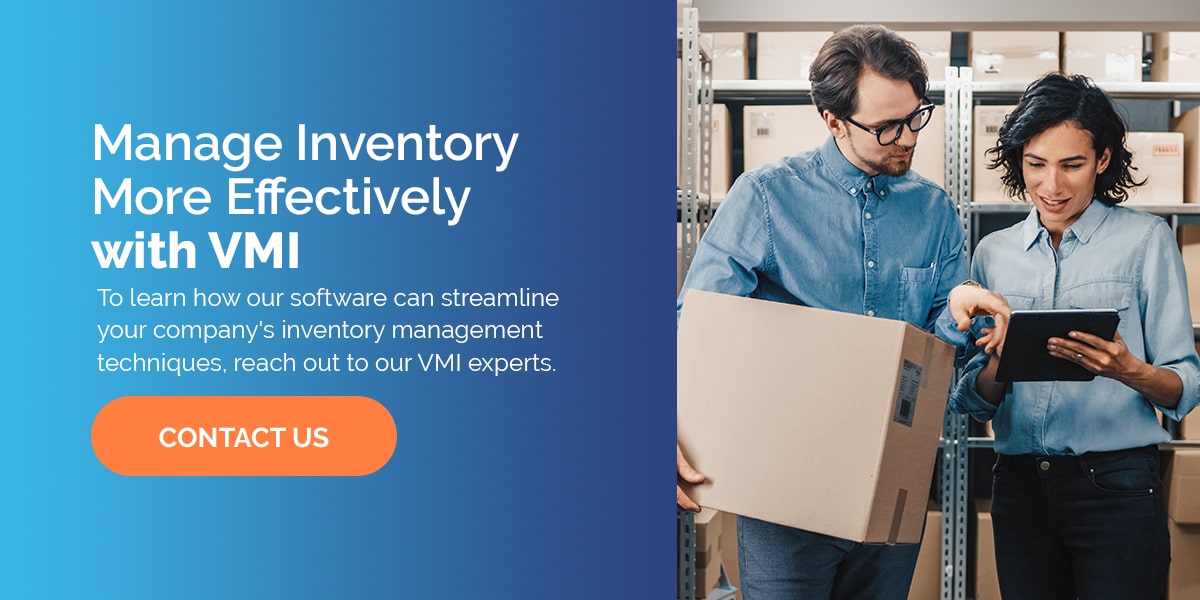7 Inventory Management Techniques for Success

March 10, 2023
Manufacturers, suppliers, and distributors must handle a wide range of challenges when overseeing their company’s inventory. From changing customer demands to overstocking and disruptions such as weather disasters, supply chain managers juggle several issues as they attempt to improve their inventory management. Companies understand that they need efficient ways to maintain appropriate inventory levels to achieve profitability, retain customers, and scale.
An effective inventory management model simplifies tracking and storing products. Many inventory management techniques are in use, but the ones that are suitable for your business depend on its specific needs.
1. Just-in-Time (JIT)
With just-in-time inventory management, companies maintain the lowest inventory levels possible to reduce costs and improve efficiency. Ordering new inventory to arrive “just in time” allows businesses to avoid overstocking and reduce waste while achieving high production volume.
However, JIT works best when companies have accurate and frequently updated demand forecasting tools. In times of supply chain disruption, JIT can leave businesses empty-handed if they fail to adequately account for risks and fluctuating customer demand. One way businesses achieve better results with JIT inventory management is with a Vendor Managed Inventory (VMI) solution. VMI is a collaborative inventory management system where suppliers and customers work together to ensure partners receive the right quantities of products at the right time.
JIT will likely evolve in future supply chains to better balance efficiency with risk management. Businesses could find it beneficial to use JIT for some products while keeping a larger inventory of more popular items to avoid the fallout from potential disruption.
Watch our Webinar: What is Vendor Managed Inventory?
2. Economic Order Quantity (EOQ)
Businesses use the economic order quantity inventory management technique to maximize reorders while minimizing holding and other inventory costs. When companies calculate EOQ, they determine how much inventory to order in each batch to reduce its total inventory costs, including holding and setup costs. A company using the EOQ method is considering what order quantity would be most economical for them to order and store.
The EOQ inventory management technique seeks to reduce the frequency of orders and avoid excess inventory. This model assumes that customer demand, holding costs, and ordering costs are constant. These assumptions can make it difficult for companies using EOQ to respond quickly to unpredictable events, such as changes in demand and lost revenue from inventory shortages.
3. Minimum Order Quantity (MOQ)
Another inventory management model that helps businesses determine when to reorder products is minimum order quantity. MOQ is the minimum amount of each unit a supplier is willing to fulfill in an order. When a supplier uses MOQ, it may turn away customers because their order doesn’t meet the required minimum. MOQ helps companies maintain a certain sale margin.
Suppliers with a high MOQ may need to keep large quantities of the product on hand. Maintaining substantial amounts of inventory ties up warehouse space and capital, but a high MOQ can also reduce ordering costs. Suppliers with a low MOQ may not keep a substantial amount of inventory. This situation could translate into higher inventory turnover and order costs.
4. ABC Analysis
One of the most-used inventory management techniques is ABC analysis. This model tells a business which products are the most profitable, costly, and fast-moving. Companies using ABC analysis order products by importance to determine which are most critical to their success.
ABC analysis evaluates products by their demand, costs, and associated risks, classing them accordingly:
- Class A products bring in the most profit, cost the least to store, and are therefore the most valuable. A products also move the fastest.
- Class B products are midrange items that are still valuable but less so than Class A. B products move slower than A products but faster than C products.
- Class C items have the lowest value, are the slowest moving, and may be costly to store.
An effective method for implementing ABC analysis is using VMI, which enhances communication between supply chain partners to increase efficiency and sales. A VMI solution enables item stratification, enabling companies to sort items into groups with different inventory management objectives. Suppliers using VMI can automate replenishment orders for their Class A products on a different schedule than Class C items and improve order fulfillment.
5. Drop Shipping
Drop shipping is a shipping practice where the retailer receives an order and ships the products directly from the supplier. This inventory management model eliminates the need for storage facilities and reduces the amount of inventory a retailer needs on hand.
Drop shipping offers several benefits, including low operational costs, increased protection against market changes, and the opportunity for a larger customer base. Drop shipping works most effectively with rare orders and items a retailer can’t store in its warehouses. This model may not be suitable for companies that want complete control over interactions with customers since their supplier fills orders.
6. Materials Requirement Planning (MRP)
Manufacturers using a materials requirement planning model use sales-forecast data to determine the number of materials and components they need on hand and when to assemble the finished products. This inventory management technique balances product quantities with production timelines to help streamline the production schedule. The MRP technique allows companies to reduce warehousing costs and improve their ability to meet demand. Another essential function of this model is scheduling production to avoid delays.
The success of MRP relies on the quality of the data a company uses in its calculation. Information such as sales forecasts and orders must be updated. Companies should also keep a single bill of materials and maintain real-time insight into their inventory. The better a business is at capturing inventory data, the better its results from using MRP.
With VMI software, manufacturers can benefit from updated data on sales, inventory positions, and product transfers. VMI calculates orders based on mutual business objectives such as replenishment frequencies, in-stock percentages, and transaction costs. This data allows manufacturers to react quickly to changing needs and fill customer orders.
7. Demand Forecasting
Demand forecasting helps companies understand how much of each product they need to fill orders and meet customer demand. This model uses predictive analytics to anticipate demand based on historical sales data. Improving visibility into customer demand allows businesses to make more data-driven inventory management decisions.
Companies using VMI gain that critical insight into demand and leverage it to improve order fulfillment. VMI expedites order forecasting by tracking demand forecast data from distribution partners and creating a recommended replenishment order based on agreed-upon factors and objectives. VMI allows companies to set reorder points and creates a demand-driven supply chain.
Manage Inventory More Effectively with VMI
Effective inventory management is critical for overseeing everyday business operations and proactively managing supply chain risks. With the proper inventory management techniques, companies can optimize their inventory to increase customer satisfaction, improve supplier relationships, and grow their business. VMI software is one of the most effective tools for ensuring the correct amount of inventory is in the right place at the right time.
TrueCommerce offers comprehensive VMI software that gives suppliers real-time visibility into their customer’s inventory levels and automates replenishment. When you choose our VMI platform, your business can reduce operating costs, increase sales, and benefit from proactive monitoring. To learn how our software can streamline your company’s inventory management techniques, reach out to our VMI experts.
Share this post:
Stay ahead of the competition
Get expert supply chain insights delivered directly to your inbox weekly.

